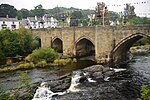The Llangollen Canal (Welsh: Camlas Llangollen) is a navigable canal crossing the border between England and Wales. The waterway links Llangollen in Denbighshire, north Wales, with Hurleston in south Cheshire, via the town of Ellesmere, Shropshire. The name, which was coined in the 1980s, is a modern designation for parts of the historic Ellesmere Canal and the Llangollen navigable feeder, both of which became part of the Shropshire Union Canals in 1846.
The Ellesmere Canal was proposed by industrialists at Ruabon and Brymbo, and two disconnected sections were built. The northern section ran from Ellesmere Port on the River Mersey to Chester, where it joined the Chester Canal, and opened in 1795. Work on the southern section began at Frankton, with a line southwards to Llanymynech, and subsequently, a second section was built westwards towards Trevor. This involved crossing the Afon Ceiriog and the River Dee, which was achieved by building two vast aqueducts, using iron troughs to contain the water. The Ceiriog was crossed at Chirk, and Chirk Aqueduct opened in 1801, to exploit local supplies of iron and coal. The canal then passed through Chirk Tunnel, and reached the southern end of Pontcysyllte Aqueduct in 1802, which was not completed until 1805. To join the two halves up, a heavily engineered route from Trevor Basin via Ruabon and Brymbo to the River Dee at Chester was planned, but very little of it was built. Instead, the present route from Frankton to Hurleston Junction on the Chester Canal was constructed, and opened in 1805. As the route never reached the water reservoir at Moss Valley, Wrexham (built in 1786), a navigable feeder was built to Llantisilio where the Horseshoe Falls weir was constructed on the River Dee to supply the canal.
As part of the Shropshire Union system, the canal from Hurleston to Llangollen thrived until the end of the First World War, after which it saw very little traffic. Navigation was formally abandoned under the terms of an Act of Abandonment obtained by the owners, the London Midland and Scottish Railway, in 1944, but the channel was retained as it still supplied water to the main line of the Shropshire Union, and subsequently to the Mid & South East Cheshire Water Board. This arrangement was due to end in 1954, but as there was no alternative supply of water, the powers were extended. Early pioneering cruises of the waterway were made by Tom Rolt in 1947 and 1949, and despite it being officially closed, a number of boats started to use it. There was a growing campaign to reopen it, but it was still designated as one of the 'waterways having insufficient commercial prospects to justify their retention for navigation' under government papers published in 1955 and 1958. It was not until the passing of the Transport Act 1968 that the route was finally designated as a cruiseway, and its future was secured. As leisure use of the canals grew, the route was rebranded as "The Llangollen Canal" in the 1980s, and it has become one of the most popular routes for holidaymakers. Its importance in the history of the British canal system was recognised in 2009, when the 11-mile (18 km) stretch from Gledrid Bridge near Rhoswiel to Horseshoe Falls including Pontcysyllte and Chirk aqueducts was declared a World Heritage Site by UNESCO.









